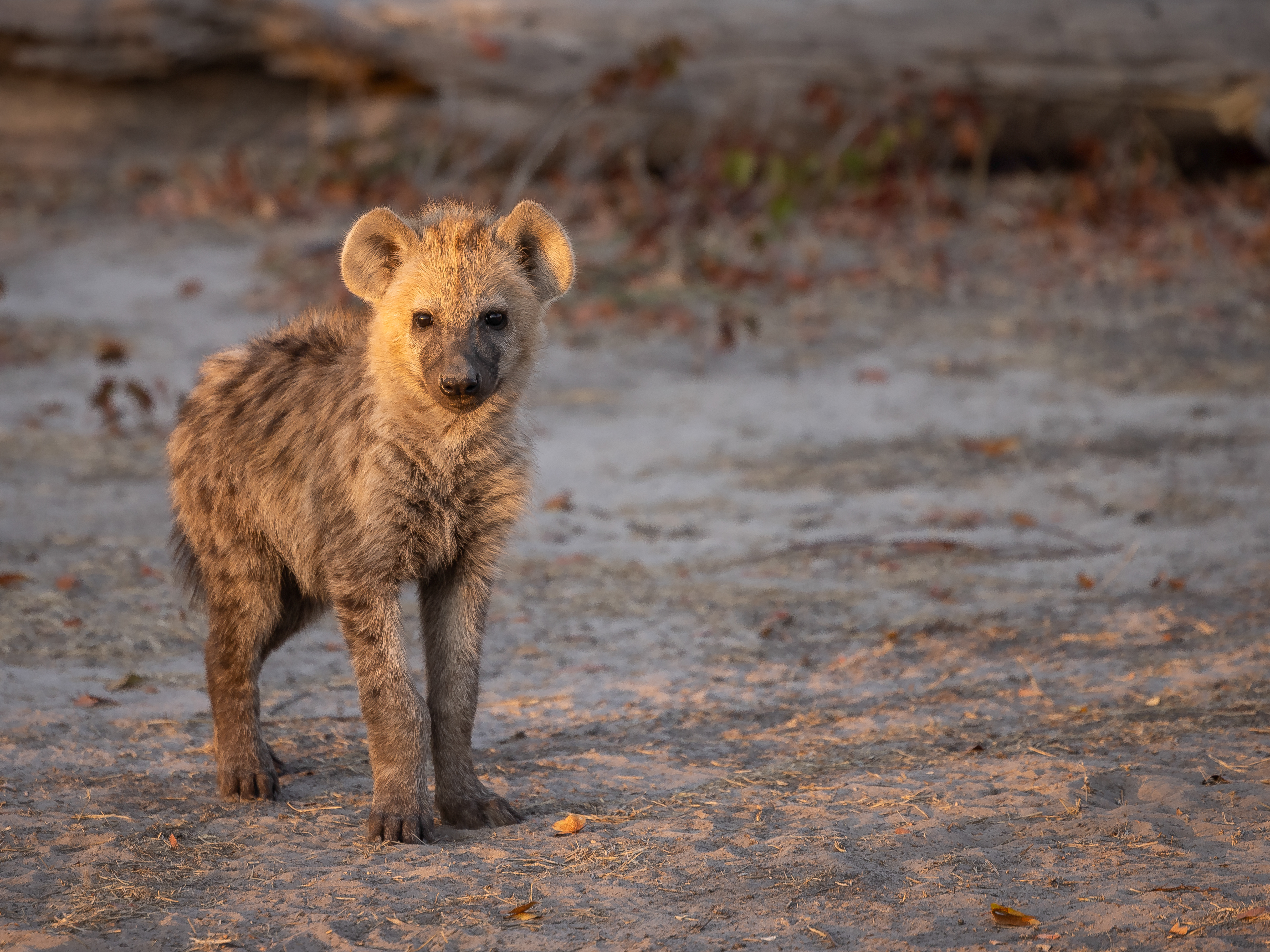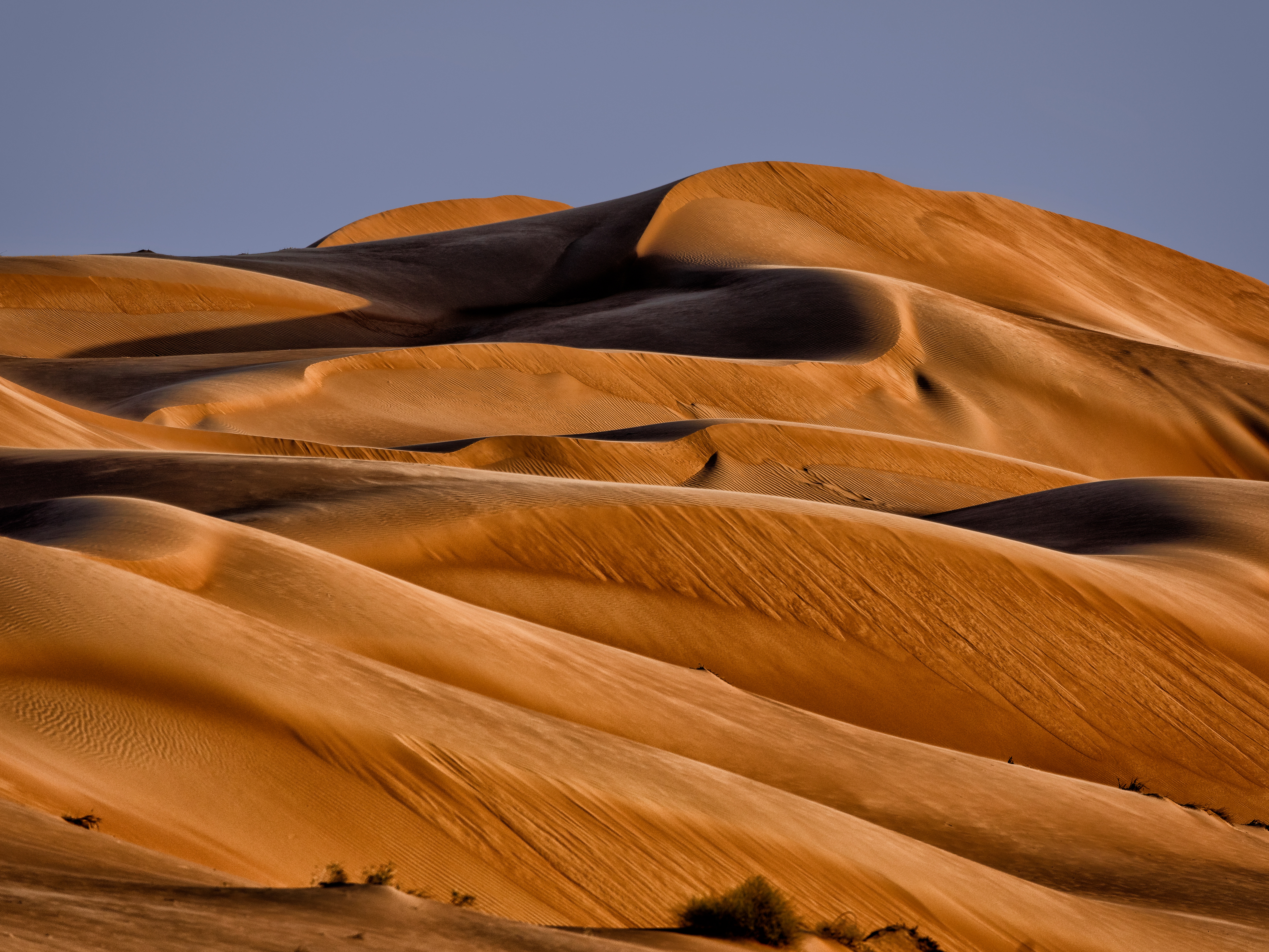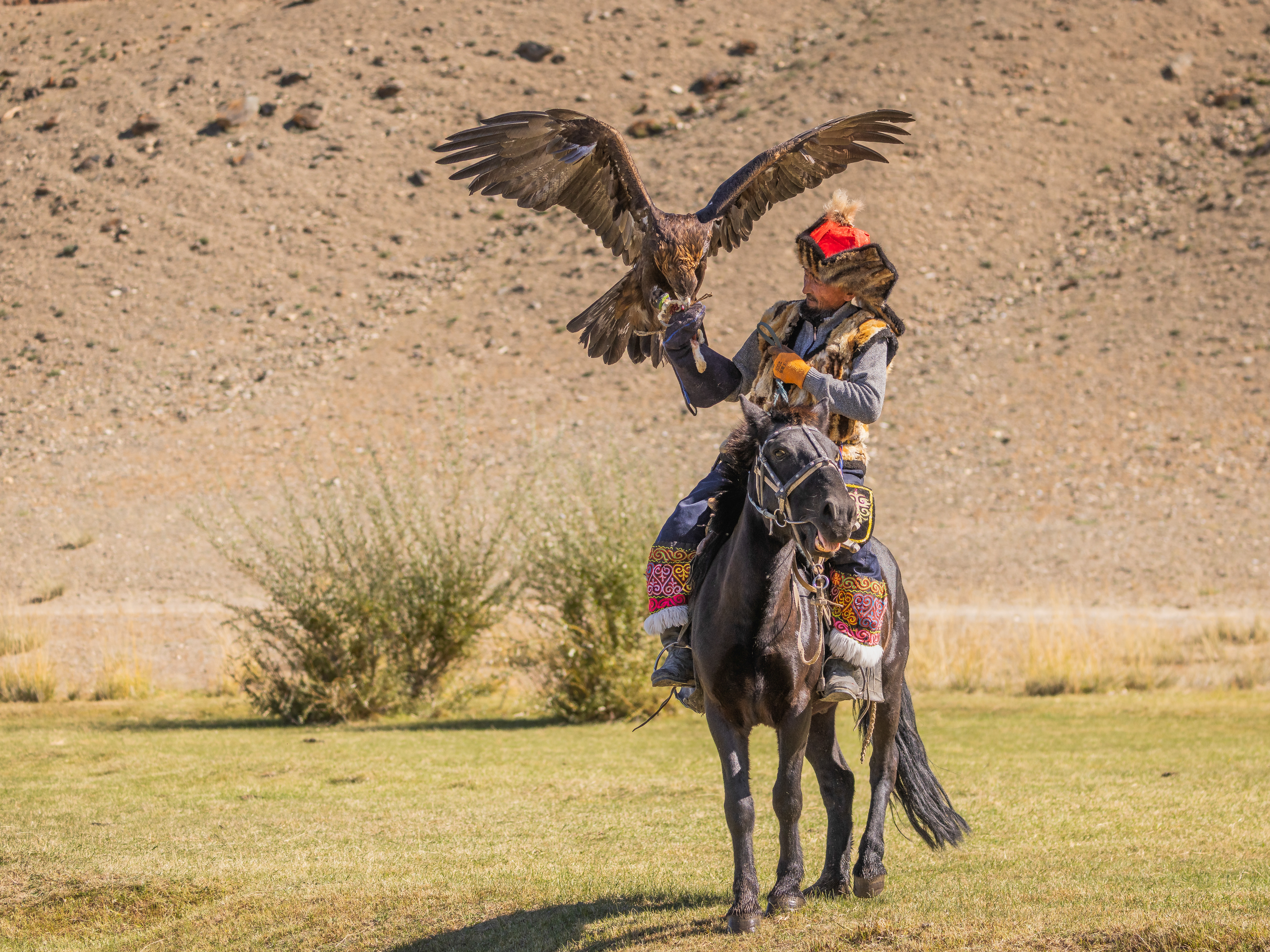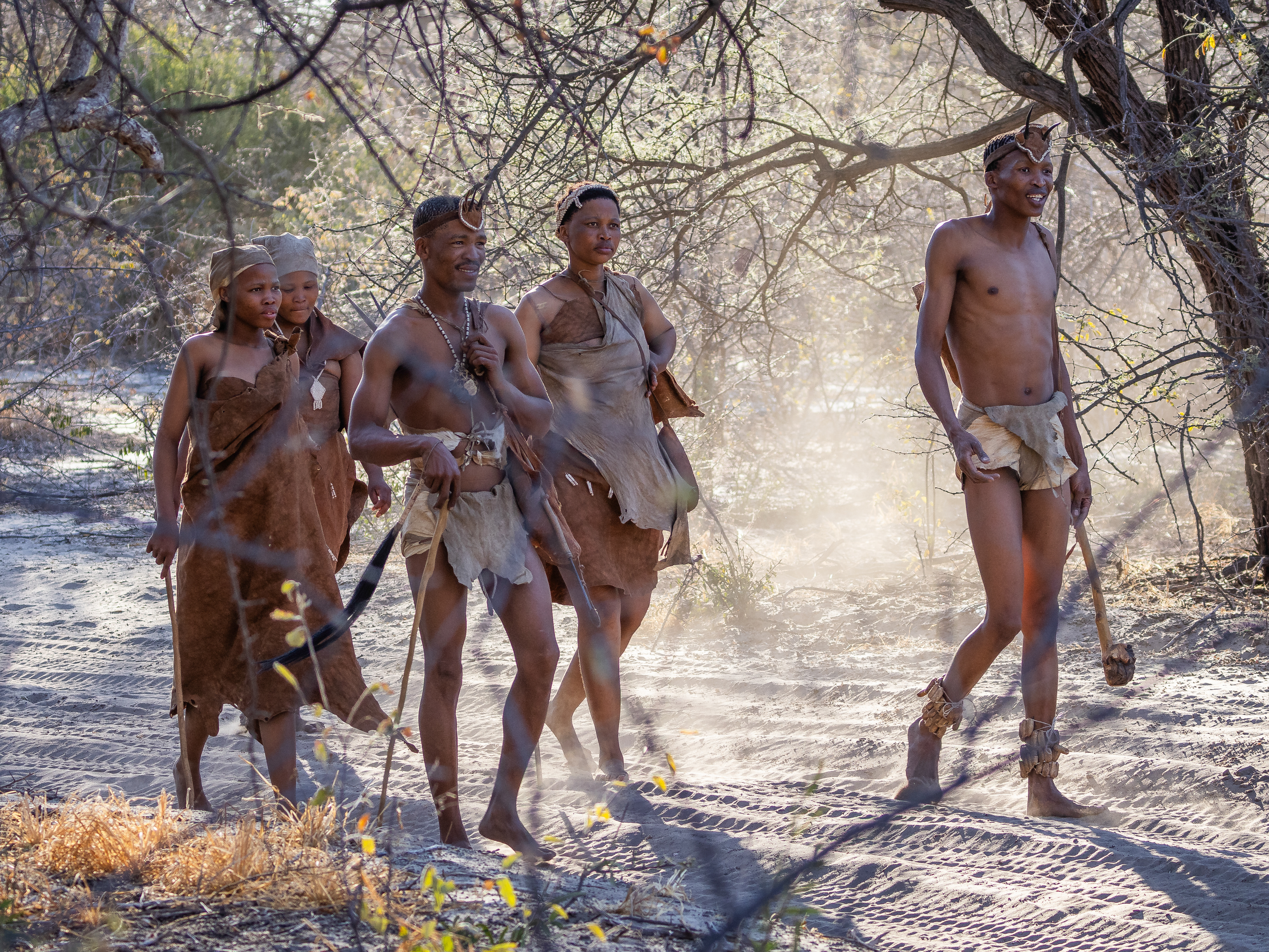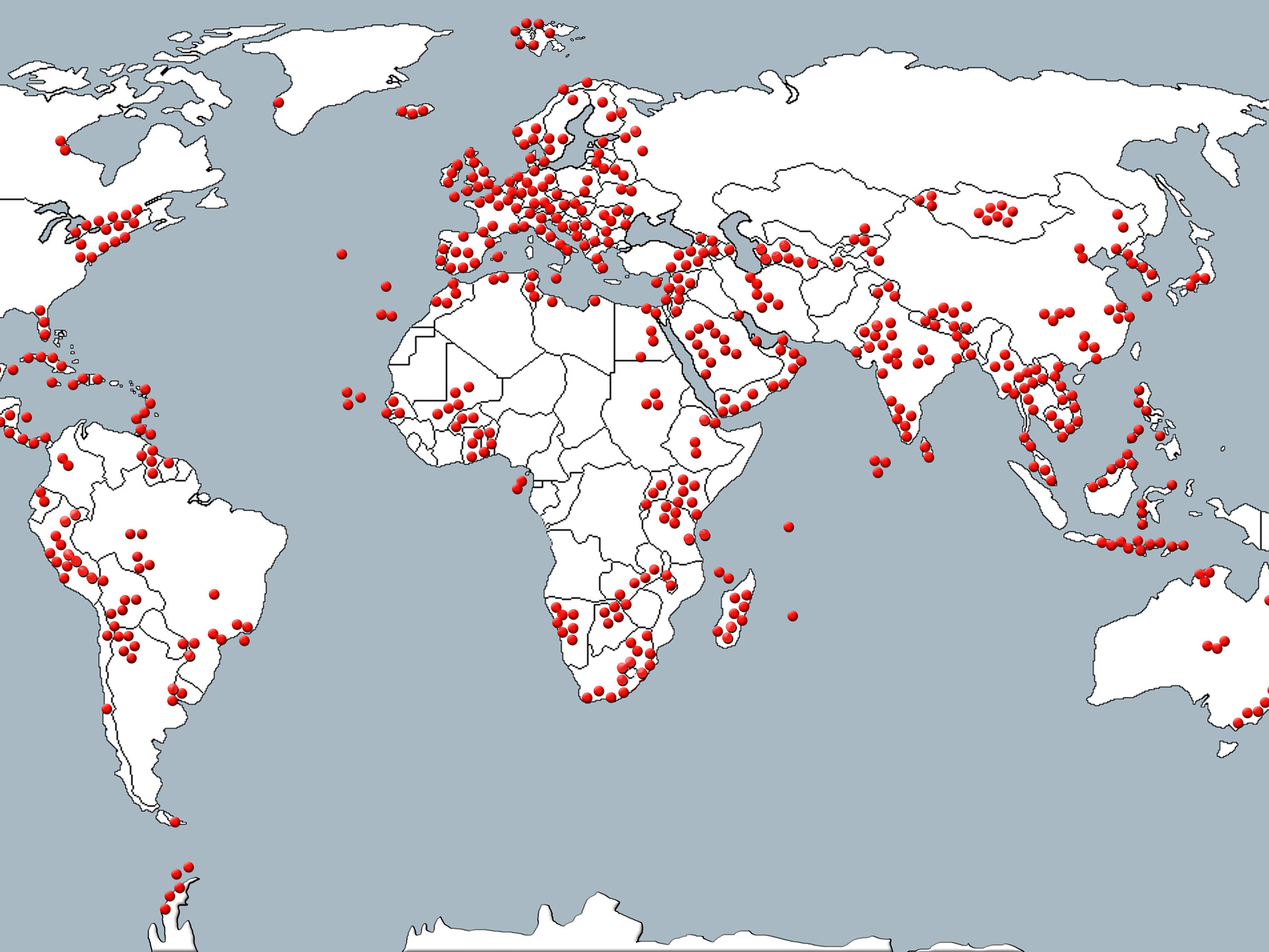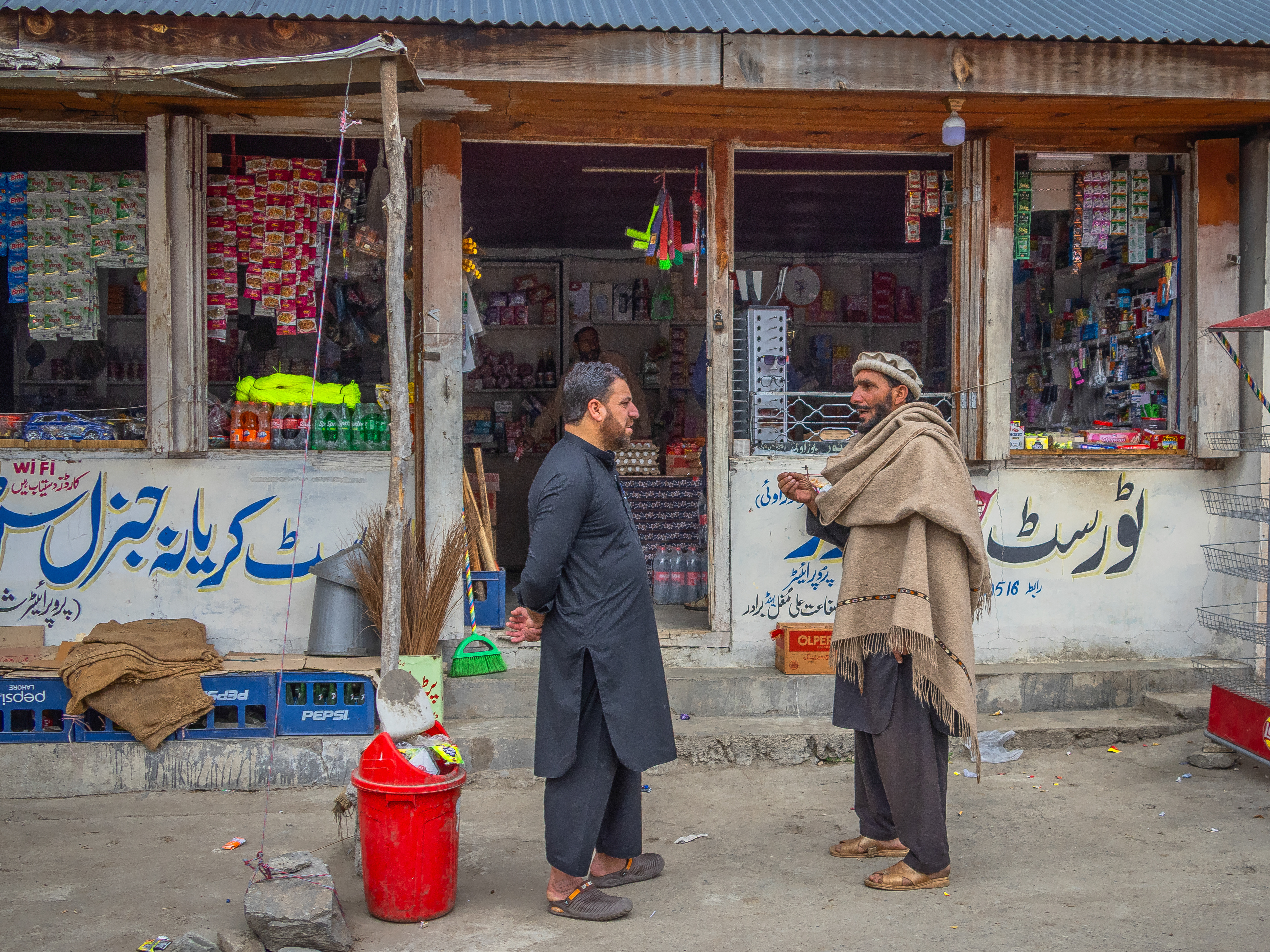A young Afar nomad leads his camel amongst the surreal rock formations at Lac Abbé. Situated in the middle of the hot and hellish Afar Depression near the border between Djibouti and Ethiopia, the salt lake is surrounded by clusters of massive, steam-blasting limestone chimneys. Rumour has it that Planet of the Apes was filmed here.
This place was an absolute nightmare to get to: we drove all day from the coast - first on reasonable roads, then after racing the other 4WDs across the flat desert, the real fun began: heading into the hills, where roads were no more than rough gravel paths and sometimes not even that. We were in a convoy of three Landcruisers, each of which carried two spare tyres, which was just as well as we ended up using five of the six - we had one puncture after another on the rough terrain.
Once we reached our destination, we stayed overnight in very simple local nomad tents and got up before the crack of dawn to witness the sunrise over these amazing rock formations. It was well worth it, despite five flat tyres, a broken axle and brake failure between the three vehicles.
To the Bwaba people of Boni village in Burkina Faso, mask dancing plays a central role in their traditional culture, combining the creation myths of the clans with the cycle of life amongst the villages. They believe that the animal and bush spirits portrayed by the masks enter the masks and become the means by which the prayers of the people are transmitted to the heavens. The masks are used during dances such as this one, to communicate with the ancestors and the gods.
The dance was not something that was put on for us tourists; our trip was timed to coincide with the dances that happen at this time of year to celebrate the end of the harvest.
The people of Burkina Faso are 25% Muslims, 10% are Christians, and 100% are animists who follow traditional beliefs, based mainly on ancestor and spirit worship. The Bwaba seek the help of powerful spirits who live in the wilderness around their village, and create masks to control these forces and help ward off the powers of destruction.
The animal masks follow a general stylistic pattern. They have large round protruding eyes, surrounded by concentric circles, and a short triangular shaped snout. Decorative geometric patterns cover the whole surface.
Accompanied by drummers beating the special rhythm of each mask and greeted by the audience with songs, each dancer gives a solo performance, while the rest look on. The music is monotonous but hypnotic and the dancers appear to fall into a trance, losing control of their movements and having to be restrained by others to stop them hurting themselves.
Forte São Sebastião, São Tomé
The fortress was built in 1566 by the Portuguese in order to protect the port and city of São Tomé against pirate attacks.
Clicking on the image will take you to my travel blog where you can read more about our visit to São Tomé.
In 2001 we took what was one of our more intrepid trips, with six days hiking in the Dogon Escarpment in Mali, followed by an adventurous boat trip.
For three days, this small pinasse was our home as we made our way down the River Niger from Mopti to Timbuktu.
We'd stop at various villages along the way, wade ashore (I have to admit I found it quite unnerving when my feet sank deep in the 'mud' on the river bottom) to explore and meet the local villagers.
Often the crew would have to get out to push the boat, as the water was dangerously low after months of no rain.
In the evening we'd pull up somewhere that looked suitable and pitch our tents while the crew prepared dinner.
The first night we'd almost finished getting the tents erected when out of nowhere the wind blew up, and with it the fine desert sand. We quickly got inside the tents to secure them. The sandstorm was so ferocious that one petite girl found herself being lifted off the ground with the tent! A heavy but brief rain shower followed, and half an hour later – as suddenly as it started – it was over and all was calm again.
While this was going on, the crew had prepared dinner from fresh fish caught from the river. The only casualties were a tent cover and some paperwork which blew away.
The following night was warm. Very warm, so I took my sleeping mat outside the tent and went to sleep under the stars. The next morning I woke early to a strange sound, only to see two massive hippos grazing on the river bank some 20 yards away. Knowing that hippos kill more people in Africa every year than any other animals (apart from the mosquito), I certainly made a hasty retreat back into the tent!
Arriving at Timbuktu was a disappointment. I don't know what I was expecting from this legendary city, but what I found was a collection of mud brick buildings slowly being swallowed up by the Sahara.
In 2003 we embarked on a trip through Namibia with a small group of people in an overland truck. It was a self-help camping trip, where we bought and cooked our food as a group, carried out the chores such as washing up, packing up the van, erecting and dismantling our own tents.
The atmosphere was amazing, and we all got on beautifully (apart from one person – there is always one, isn't there?) and each day was filled with laughter and fun. We saw much of what Namibia had to offer, including several days safari in Etosha National Park.
Extract from my journal from our ten day camel trek across the Sahara in Sudan in 2004, led by Michael Asher, author of my all-time favourite book: “The Impossible Journey”:
Day 3.
We walk for the first few hours, with the camels loping behind us. The camels carry a lot of heavy gear with all our personal stuff, tents, sleeping mats, mess tent, cooking implements and all our food for ten days. Water for drinking and cooking will be collected from wells along the route, while personal washing is not really included in the plan.
The weather is blisteringly hot with no relief from shade or clouds, while the scenery is uninspiring with neither impressive sand dunes, nor any kind of vegetation to break the monotony. Just sand. A few tufts of scorched grass dot the landscape and the odd dried-up acacia shrub. These plants seem to be rather small and insignificant here, unlike further south where they grow into tall, majestic trees. It's a brutal environment and we see few living creatures as we wander further into the sand sea that is the Sahara.
Although it seems to me that I am constantly drinking water and refilling my 1.5 litre bottle, I am aware that the glaring sun and unforgiving climate is taking its toll on my body and mind. Despite the frequent fluid intake, I am beginning to feel progressively unwell.
For a while the surface under our feet is soft sand that makes for hard going as the weight of my body makes me sink in, with the muscles in my ankles and calves taking the brunt of the work. Densely packed earth, baked, parched and cracked by the relentless sun gives way to gravel and stony ground seemingly sizzling in the merciless heat. This bleak and unforgiving environment demands respect, but I feel more and more ill as the morning wears on. Eventually Michael signals that it is time to stop for lunch. Close to tears and ready to give up, I struggle into the camp set up by the porters and collapse onto the ground.
A mess tent is erected offering some relief from the ferocious sun. My thermometer reads 46°C in the shade, and I feel like I am wilting, even in the shade. As my feet have been hurting for the last few miles, I carefully take my boots off, noticing both little toes are sporting blisters. Covering them with blister plasters, I put my boots on again and hope for the best.
Life around me is a bit of a blur, I hardly notice what I am eating and taking photos hasn't even enter my mind for several hours now. I must be ill!
After lunch I decide to have another go at riding. Fatima, the name I have lovingly given to my camel, is carrying bags of firewood as well as being mounted with a large wooden saddle for me. Several of the men stand by in case I fall when mounting the camel, but all goes well. I don't feel at all wobbly and the saddle is surprisingly comfortable. For the first couple of hours Fatima is plodding along quite happily, being led by Osman, while I am reasonably comfortable perched high above the ground.
Later we take a short break and Michael adjusts my saddle, moving it a little so that it is better for the camel. It may be better for Fatima, but shortly after we start off again, the wooden knob at the back starts digging into my bottom. After another couple of hours we stop again and as Fatima leans forward on to her knees and I lean backward to avoid headbutting her, the saddle totally disintegrates. I tumble, head first, onto the hard cracked earth. I don't have any pain, but feel somewhat dazed and confused. Michael is furious with the porters for not assembling the saddle properly in the first place (a basic structure, the saddle consists of pieces of specially shaped wood fastened together with rope).
I opt out of riding for the last few miles, preferring to trust my own two feet rather than the lofty animal with its rickety seat. The blisters on my feet are seriously bothering me now and I feel increasingly weary, ill and in pain as the trek seems to go on and on and on this afternoon.
Eventually we find a suitable place to set up camp and once the porters and cook have got their act together, we eat a very late dinner. It is gone 10pm by this stage, too late for me too eat (and we've been on the go since before six this morning), so instead I wander off and place my camping mat on the soft sand, settling down for a night under a starry sky.
Day 4.
With my blisters still being painful this morning, I strap my toes together with Duct tape so that they won't splay when I walk, hoping that will help; and I take a couple of painkillers too before we set off. I am as ready as I ever will be for today's hike.
We are over an hour behind schedule when we finally leave at 07:50. We lead our camels, like dogs on a walk in the park, making for quite a surreal spectacle: eight Westerners, each with a heavily-laden camel in tow, with Omran and the chef riding theirs. While David and some of the others complain of tiredness, I feel fine today, apart from the painful blisters. The landscape is still rather flat and uninteresting, but I have a lovely morning living out my dream of trekking across the Sahara with Michael Asher, just like in his book. As the sun rises higher on the horizon, the temperature increases and I try to drink enough water to keep me hydrated. The problem with such a dry heat is that I don't realise that I am sweating and thus I am not keep my fluid levels up adequately. I only come to appreciate this retrospectively, of course.
When we set off again after the mid-morning rest stop I mount Fatima and ride for a while to reduce some of the pain from the blisters on my toes and feet. After some initial wobbliness, Fatima and I get on just fine, finding a slow and gentle rhythm as we make our way across the desert. It is really hot now, with the fierce sun roasting us, the camels, the cracked earth beneath out feet and everything else in its wake.
Despite bouncing along with a spring in my step first thing today, I now feel increasingly awful: light-headed, dizzy and disorientated as well as nauseated. I try to ride it out, quite literally, but eventually I have to capitulate and call Michael over to tell him we need to stop for me to get down. I jump down on to the hot, hard sand and someone brings me some rehydration salts. Feeling more and more sick I start to heave and then promptly pass out. By the time I come to, someone has found a blanket and moved me to the shade. David, who has been bringing up the rear at the back of the camel train, rides up alongside and wants to know what all the fuss is about. One of the girls quickly explains what has happened and adds that I was convulsing while unconscious. It is not looking good. Michael asks if I feel well enough to carry on, but all I want to do is sleep, preferably in a proper bed in an air-conditioned room. It becomes obvious that I am suffering from heat exhaustion, dehydration and most probably concussion as a result of falling on my head yesterday. After much discussion it is decided that David and I will return to Khartoum while the others carry on.
With no means of communication with the outside world, Michael sends one of the young camel handlers riding off to locate the nearest settlement, and hope that someone there is in a possession of a 4WD vehicle and are able to come out to pick me up and take me back to civilisation. One of the other girls, Ali, is a trained nurse and sits with me, talking to me and trying to keep me alert while we wait. She is a sweetheart and makes me feel a lot better, at least psychologically. I hate admitting defeat and giving up, but my health must come first. David later tells me he is secretly relieved that we are going back, but right now I feel like I have let everyone down. Michael is excellent too, reassuring me that this unexpected delay is absolutely no problem. I know that it will badly mess up their day, but I haven't got any energy to argue.
Eventually, several hours later, a flat-bed truck arrives and I clamber into the cab next to the driver. There is no room for David inside, so much to his delight he is asked to stand on the back, holding on to the rails. He loves the drive across the sand, while I drift in and out of consciousness inside. The driver is surprisingly careful and considerate, but the downside of that, of course, is that we make very slow progress. There are no tracks out here but the driver seems to know where we are going. Or at least we hope so. We seem to be weaving around a little, crossing loose tracks from time to time and approaching several clusters of make-shift refugee camps (for the Darfur Displaced Persons), driving in and out of narrow lanes between the huts, shouting out something each time and receiving an answer. What on earth is going on? The driver speaks no English whatsoever, and my Arabic is limited to a few pleasantry phrases – not much use in this situation.
Having driven via six or seven such camps, we eventually stop in a small courtyard within a complex consisting of one brick building among the straw huts. We are all taken off the truck and a young boy comes out of the house to talk to us. All I can understand is “Five minutes”, “one hour”, “policeman” and “car”. I am still no wiser.
A short while later we are off again, to another refugee village. Here we are introduced to the driver's brother, who is a trainee lawyer. Our puzzlement increases, but thankfully he does speak a few words of English. He explains that a third brother is a policeman on his way to work in town and we are giving him a lift. After a while a man with a saloon car arrives and we are beckoned down from the truck and into the car. Without many options open to us, and not speaking nor understanding the local language, we have little choice but to get in. The policeman sits in the front, David and I in the back. As we head off along the dirt track at a rate of knots, we do wonder what on earth we have let ourselves in for, but I am too tired and too ill to actually give it any more thought.
We are still driving as darkness sets in, and are beginning to get a little bit concerned as to where he is taking us. We are given a glimmer of hope when we see lights in the distance. Khartoum, I presume. Before we know it, we are outside the Acropole Hotel, and the driver runs in to get the owner, George, to come out. What a welcome sight. After much discussion with the driver, he explains that the first truck which took us out of the desert is licensed only for driving in the rural areas (to do with the amount of tax paid I believe, although the lack of tyre tread is also mentioned. At this stage I don't care, we are here now) so he chartered this improvised taxi to deliver us to our hotel. Of course, the taxi driver wants payment, but we stand firm and argue that Michael paid the original driver to take us to all the way to Khartoum and emphasised that we are not to give him any more money. Eventually the guy concedes and goes away to take it up with the truck driver.
It is a relief to get inside the building with an efficient A/C. I feel instantly better. George is my Knight in Shining Armour, serving us a cold drink and installing us in a room where I promptly fall asleep.
Another adventure has come to a satisfying, although unexpected, end.
The Fire Dance was held in a clearing in the small village of Tinadou, just outside Kparatoa, some miles from Sokode in Togo. There was a large sign at the roadside advertising the dance, and villagers from many nearby settlements came to witness the show, as well as us. The dance takes place round about a month after the festival of cutlasses, with the dancers attempting to prove their prowess by various daring stunts.
Noah (our guide) explained the story behind the origin of the Fire Dance: The Kotokoli people were often fighting with the neighbouring Taberma tribe and they were regularly caught unawares whilst tending to their everyday activities. The women and children would be in the huts by the fire, and weren’t always able to escape in time, so it often happened that they got burnt. The Kotokoli therefore made a pact with the God of Fire. The dance is to recognise this alliance and celebrate it.
I really don’t know how I feel about the Fire Dance. It was spectacular of course, but what was it about it that made me feel uncomfortable? I have seen several fire dances in the past, but this one was nothing like any of them. It was more primitive, more primeval, more enigmatic and mysterious. It wasn’t just a show, it was so much more. It seemed to hold a deep-seated spiritual devotion despite its simple and unpretentious execution. It was explained to us that only a few people in the village have the gift to be able to carry out the dances, not everyone can do it.
There were many aspects to the dance, and the image shows one of the ‘acts’. A bowl with broken glass immersed in water was passed round for the audience to check out. The glass had very sharp edges indeed. Kneading the glass with his hands, the dancer would pick a handful up and thrust it into his face. He also picked up individual shards and would rub them hard against his exposed skin. You could see he was putting pressure on the glass, as his skin would give a little under the force. Or he’d try and cut his eyes or his tongue. It was grotesque and disturbing, while at the same time mesmerising!
The thing about safaris in Tanzania is that public conveniences are few and far between, and obviously 'going behind a bush' is totally out of the question with all those dangerous wild animals around.
Usually, when the need arises, our driver-guide will find an open area, with no other people around, and ideally with some plains game such as zebras or antelopes as they are the first to spot any predators.
My husband was too desperate to wait for a 'safe place', so the guide suggested he went JUST outside the vehicle with the door still open for a quick entry back in the car should there be any danger.
It wasn't a lion or leopard that turned up, however, but a flock of starlings who seemed delighted to have a hot shower!
I just love the way that bird on the right is cocking his head to look at what is going on, as if to say: “Oooh, I have never seen one of those before....”
To the uninitiated, it looks like any other Ghanaian village, but Gnani is no ordinary community. This is a village like no other village I have ever visited: the inhabitants are all witches. Gnani is one of several such villages in the north of Ghana. 640 witches live here, but it is estimated that over 2000 witches (or supposed witches) are living in exile in these type of camps. People come from as far away as Togo and Burkina Faso to seek the safety of a dedicated witches’ village.
Traditionally, if a person is condemned for being a witch, the villagers batter them to death. Simple. Here, there is an alternative. The chief of Gnani village – a witch himself – accepts, and even encourages, witches to come and live in his village. This provides a real sanctuary for those unfortunate individuals who have been accused of witchcraft. There are laws in Ghana that forbid banishment and rituals that violate human rights, but no one has even been known to have been charged, let alone convicted, of accusing a woman of witchcraft. Witchcraft is a very emotive subject, and one that we do not fully understand in the West.
Unlike the first witch we spoke to, this lady admits to having carried out witchcraft and confesses to having killed several people using her supernatural powers. She claims to have done it purely to protect her family, but was banished to Gnani when she was found out. Since coming to the witches’ camp at Gnani, her paranormal powers have been extinguished through the ritual carried out by the chief and she assures us she is no longer a danger to society. This is the first time I have actually been in close proximity to a self-confessed serial killer!
Canoeing on the Zambezi River in Zimbabwe, getting within feet of elephants drinking at the side of the river.
One of the many aspects of travel that keeps me jetting off to far-away lands at every opportunity, is the fascinating experiences we have, learning about other cultures.
Burkina Faso 2010
Tenkodogo is the heartland of the Mossi tribe and this area is considered sacred to the Mossi people. This is where the king resides, and many locals will come here on a pilgrimage to see the king and visit the sacred land.
Janvier (our guide) managed to arrange for us to have an audience with the Mossi King, and we went to see him in his traditional meeting house within the grounds of the Royal Palace.
The meeting house is made from three circles of poles supporting a straw roof. Within the outer circle sit the local chiefs and village elders, and the king sits on his throne in the centre.
The entrance is deliberately low so that everyone who enters has to bow to the king. The chiefs and elders will also prostrate themselves on the ground in front of the king before taking their positions.
The king has five million subjects, and many come here to ask questions or get the king to settle disputes. These people sit outside the meeting house until their turn comes to address the king.
The king studied English in a management school in Japan, and spoke to us in good English. He was a financial minister and later an MP, but was forced to return to Tenkodogo when his father died in 2001 in order to take over the role as king of the Mossi people.
Lake Assal– meaning 'honey lake' in Arabic - is a saline crater lake located in a depression at the northern end of the Great Rift Valley in Djibouti. At 155m below sea level, is the lowest point on land in Africa. No outflow occurs from the lake, and due to high evaporation, the salinity level of its waters is 10 times that of the sea, and it is the world's largest salt reserve. The salt content makes the surface on the shallow edges crusty to walk on – a very strange sensation.
We crossed the waters between Fogo and Brava, Cape Verde Islands, in a small cargo ship without stabilisers. There were no proper seats as such, we just perched on packing cases or boxes. Close to 80% of the passengers were being sick, including one of the many goats!
It was one of the wildest crossings I've ever known and certainly one of the wettest! With each wave, the water came crashing over the side of the boat, soaking us to the skin.
Who would have thought that a coffin maker could be so interesting? The coffins in the workshop in Tema, Ghana, were all a little bit different.
It is an old custom in Ghana that when a rich merchant is buried, his coffin is shaped to represent the life he led when he was alive. Hence coffins are made in the shape of cars, birds, fruits and vegetables, shoes, cigarettes, mobile phones, and a host more interesting shapes. It sure beats being buried in any old plain wooden box.
There were coffins everywhere, each one artistically crafted and beautifully finished; with the interior lavishly padded and completed with shiny silk to make the journey to the afterlife as comfortable as possible. I
It made me think. I wonder what shape I would like my coffin to be. A bank note (from my days working in a bank), or maybe a globe, to represent my interest in travelling? This plane would be very suitable for me I think; or possibly a camera.
How would you like your coffin to be shaped?
Walking through Moroni Old Market in Comoros, most of the stall holders did not want to be photographed, but this lady was different. Not only did she ask if we'd take a picture of her daughter, she literally begged us to take her young child back to England with us "to give her a better life".
I struggled to hold back the tears when I realised that this mother was so desperate to give her child a better future that is willing to 'give her away' like that.
Like so many times when we travel, I counted my lucky stars that evening as that is one of the saddest things I have come across.
Pyramids of Meroë
The road from Khartoum travels through miles and miles and miles of featureless desert landscape. Not that it matters, as I spend most of the journey sleeping anyway, having been out of action for the last 24 hours due to heat exhaustion. Each time I wake I see dust hanging in the air, and the occasional camels, goats and mud huts.
Then I spot them in the distance. The forgotten pyramids of Meroë. Smaller, and nowhere near as famous as the pyramids of Egypt, it is an interesting fact that Sudan has almost twice as many pyramids as its neighbour.
The ancient kingdom of Meroë, also knows as Kush, became one of the most important empires of the ancient world. Built between 2,700 and 2,300 years ago, there are around 250 pyramids here, and just two tourists. David and me.
The Sahara Desert threatens to reclaim this UNESCO Heritage Site, and as we wander amongst its abandoned tombs, I can easily imagine how the early explorers felt when they stumbled across such exciting discoveries after lengthy explorations. For me this is another one of my bucket lists experiences, somewhere I never expected to be able to go.
